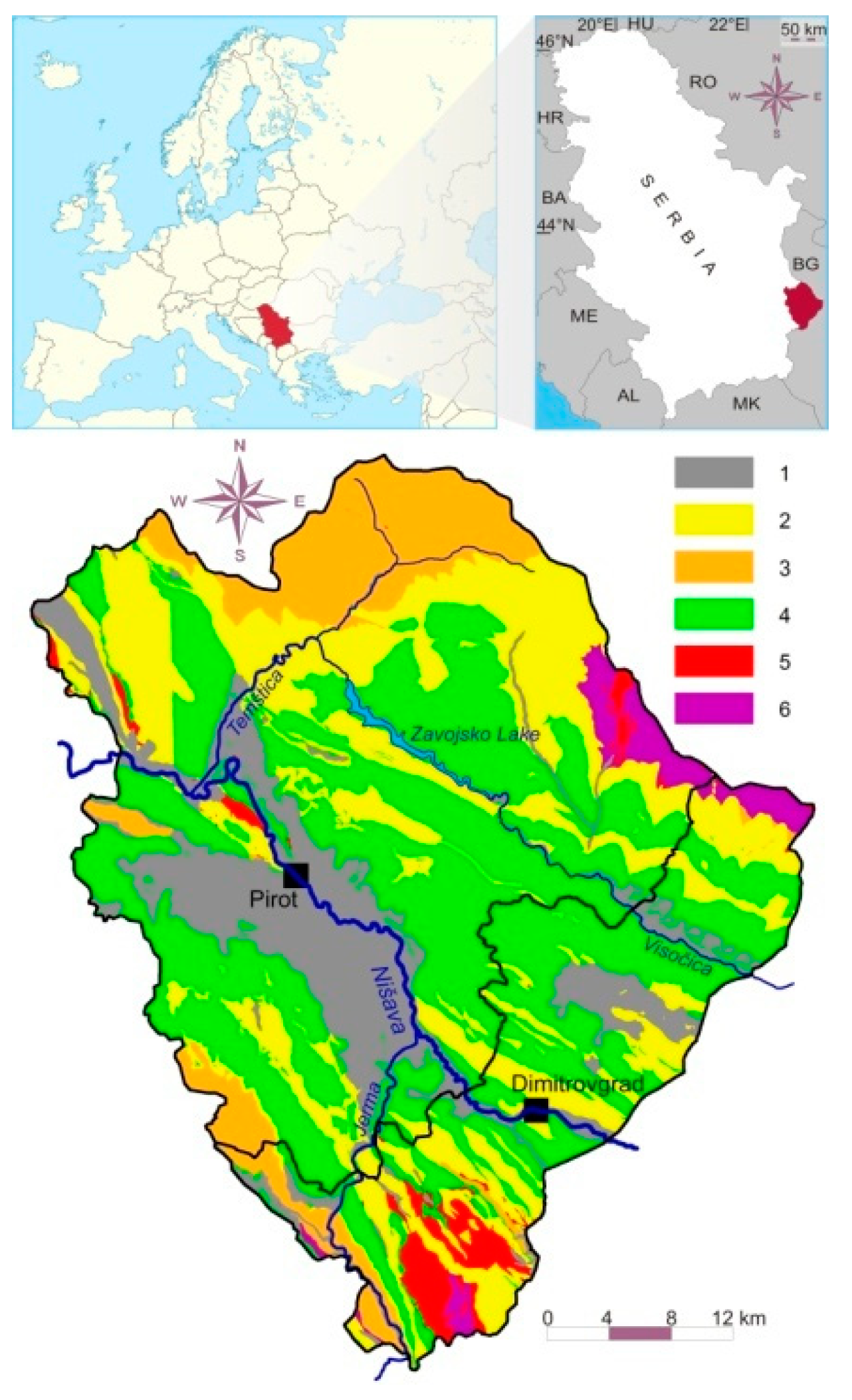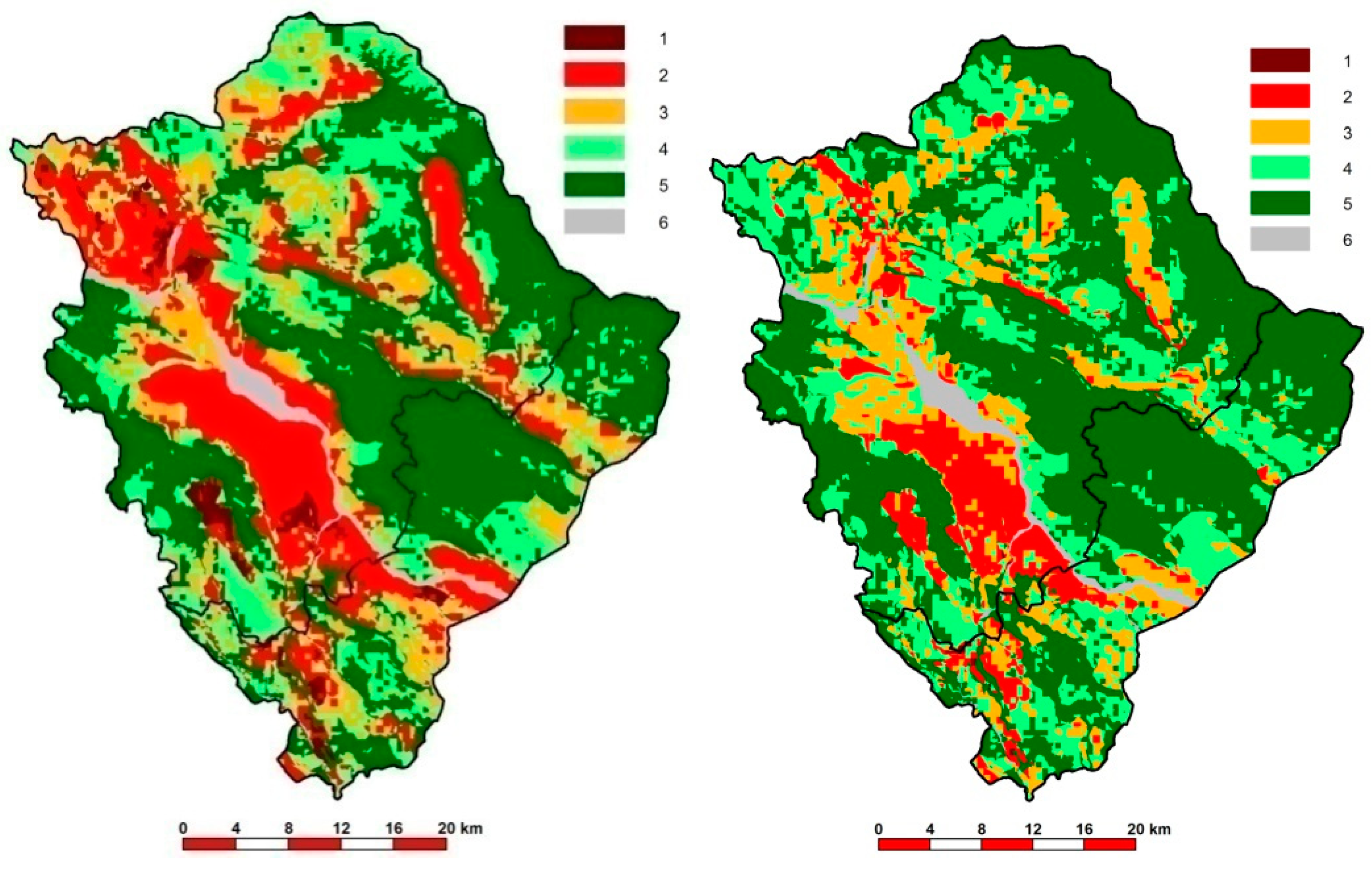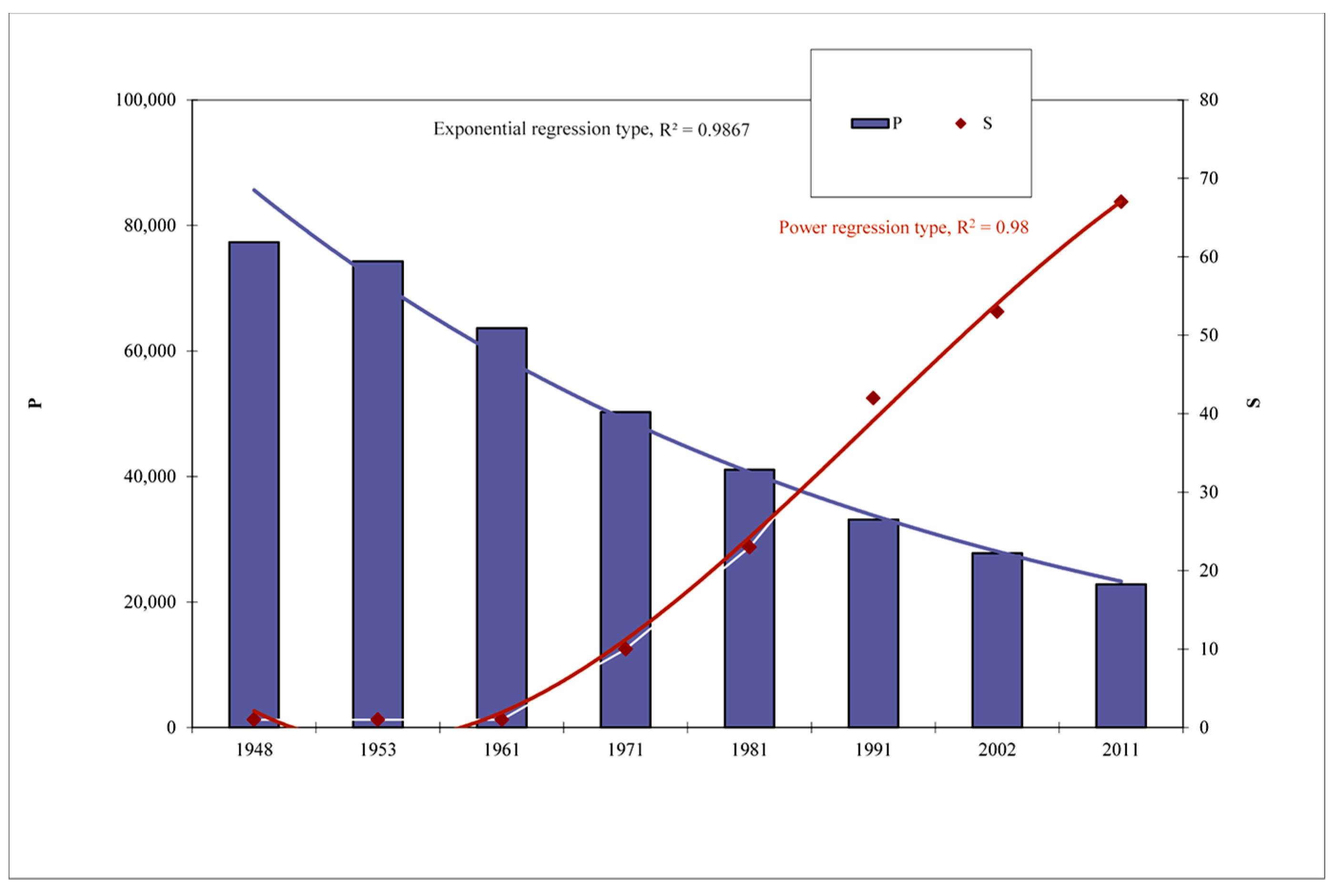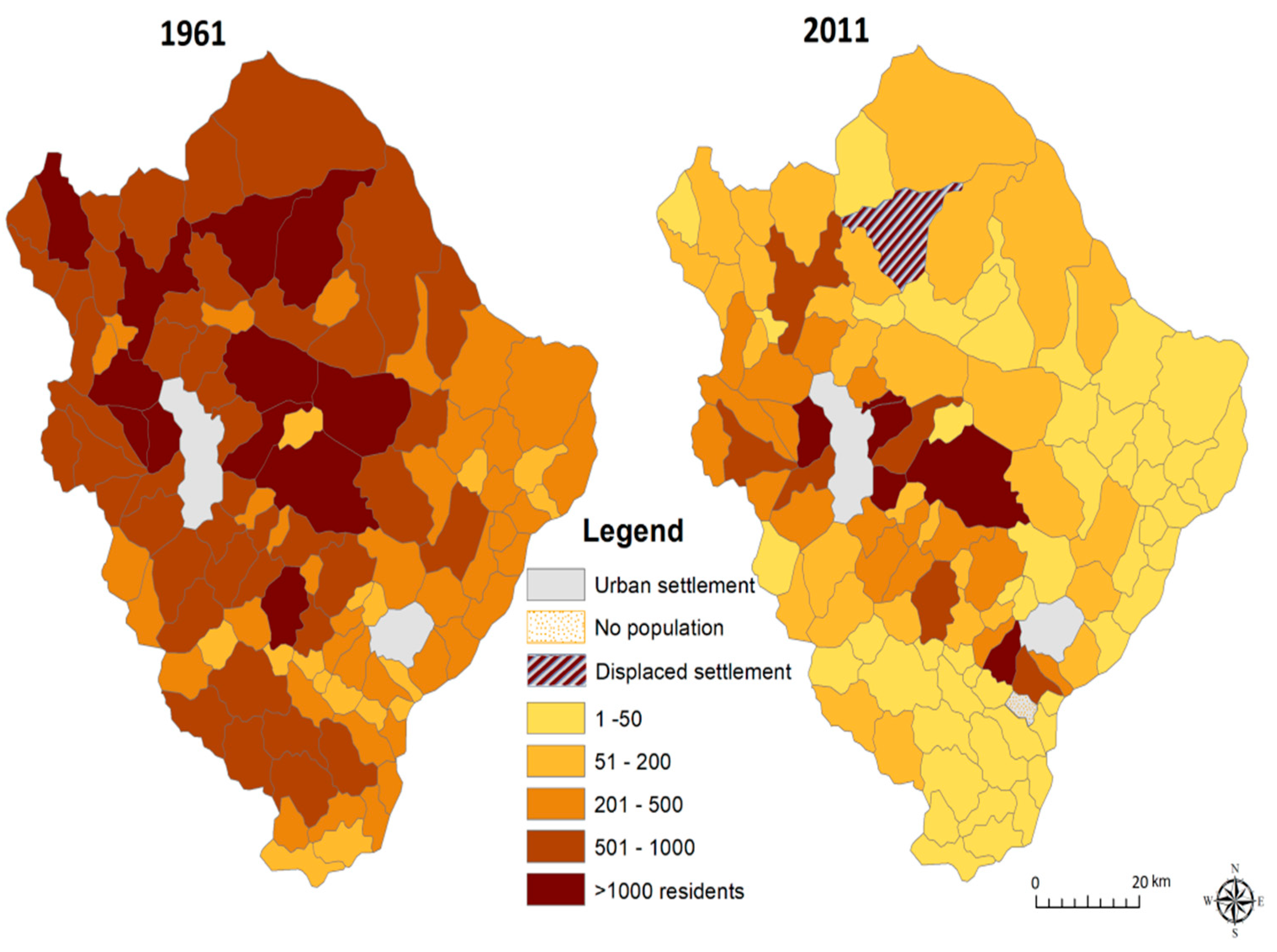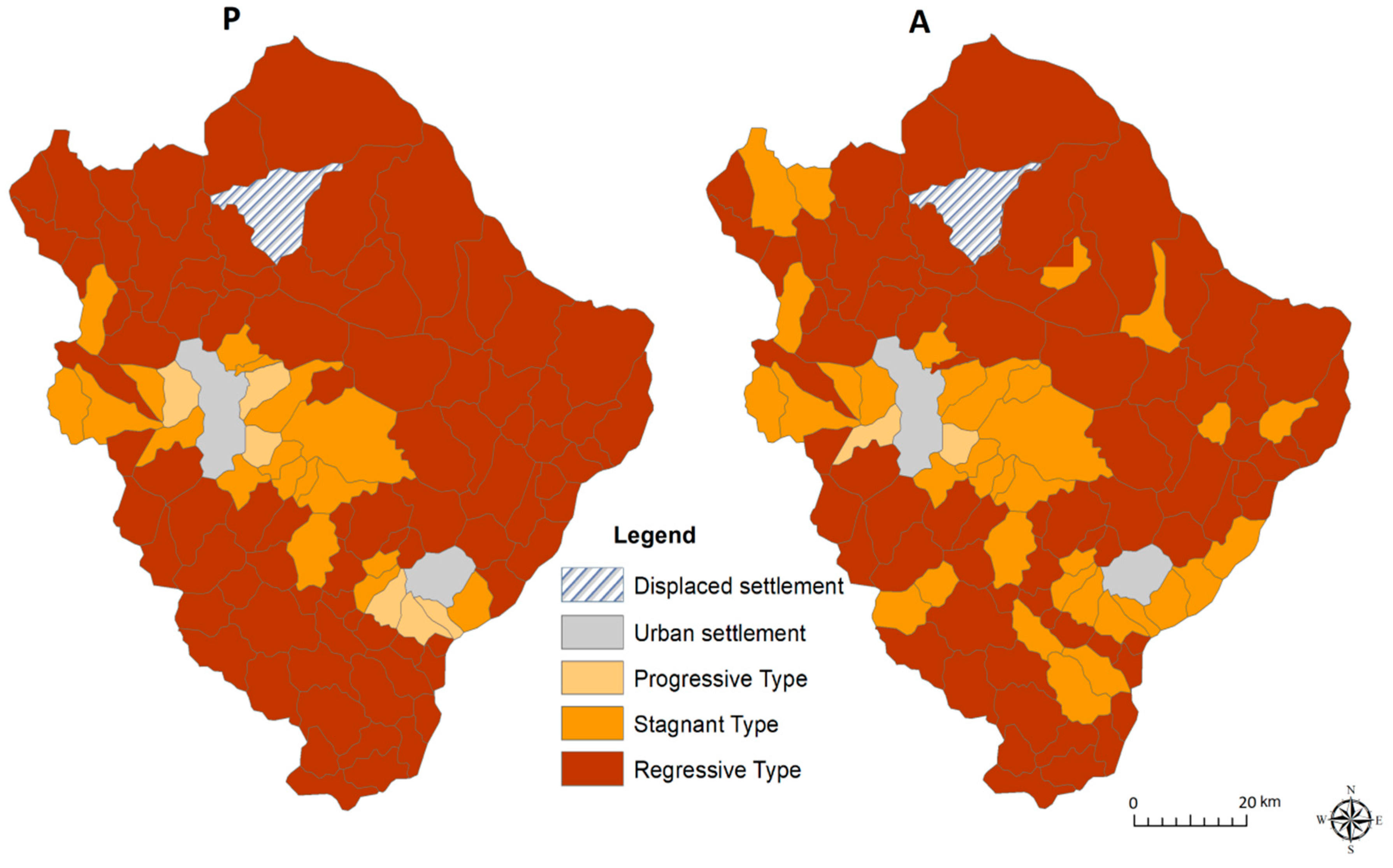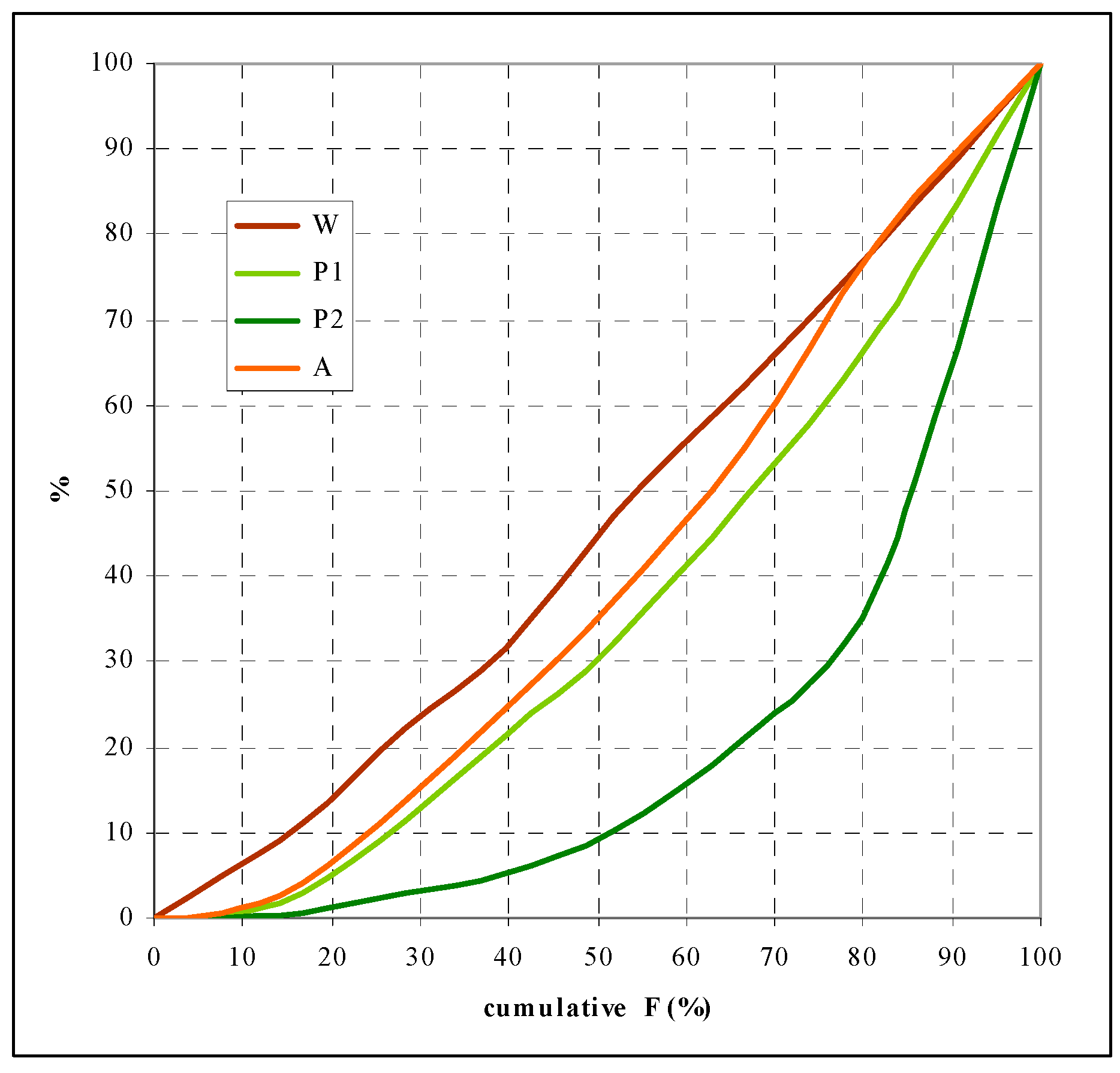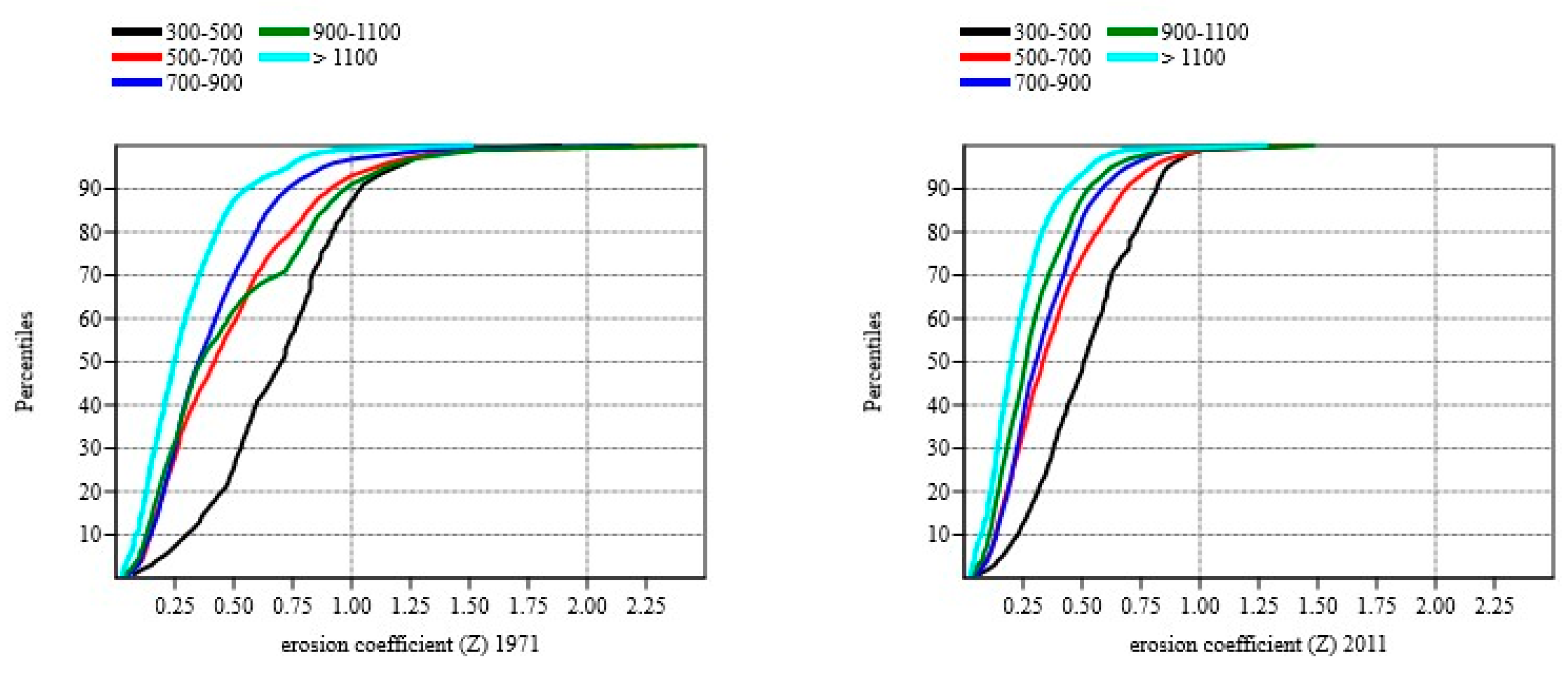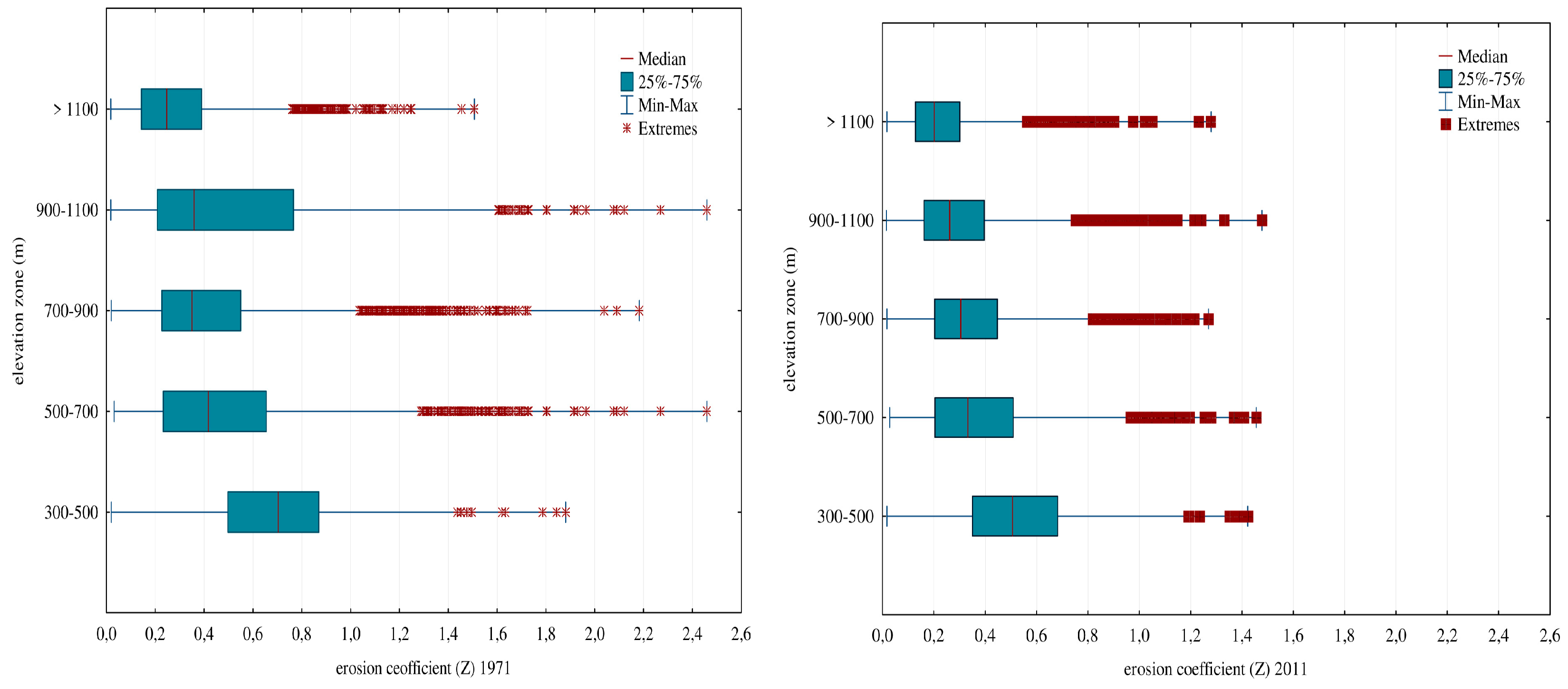4.1. Spatial-Temporal Distribution of Erosion Coefficient (Z) and Specific Annual Gross Erosion (W0)
Spatial-temporal redistribution of erosion intensity is given in
Figure 2, and changes in the erosion coefficient in
Figure 3. According to EPM, the excessive erosion and intensive erosion categories were spread on 327.6 km
2 (18.6%) of the study area in 1971, while in 2011 this area comprised only 113.8 km
2 (6.6%). The results also indicate that 428.9 km
2 (25.0%) in 1971 was under the influence of medium erosion, while in 2011 this area was 452.6 km
2 (26.4%). A significant part of the territory with a surface of 922.9 km
2 (53.8%) in 1971 and 1103.9 km
2 (64.4%) in 2011 was influenced by weak erosion and very weak erosion. Only 2.6% of the territory was under the opposite process of accumulation.
According to the coefficient and erosion category, erosive processes in 1971 were in the category of medium erosion, Z
1 = 0.419, i.e., category III of destruction. The average erosion coefficient in 2011 was Z
2 = 0.333 (category II of destruction). It can be concluded that the resulting changes during the analyzed period caused the reduction in intensity of the erosive process for one category (
Figure 3).
Spatial distribution of the average specific annual gross erosion in m
3/km
2/year in the rural areas of Pirot and Dimitrovgrad municipalities is presented in
Figure 4. The results indicate that more than 78% (1368 km
2) of the observed territory is under significant, weak, and very weak erosion. Medium erosion is in almost 12% (206 km
2) of the study area. Intensive erosion, which ranges from 1200 to 3000 m
3/km
2/year, occupied 8% (142 km
2), and extensive erosion, at more than 3000 m
3/km
2/year, occupied extremely small areas.
The results show that specific annual gross erosion was W
1 = 673.6 m
3/km
2/year in 1971 and W
2 = 440.0 m
3/km
2/year in 2011 (
Figure 4), which means that the reduction in erosion was 35%. The biggest changes in this period were referred to erosion categories I and II. Areas in erosion categories I and II comprised about 20% of the observed territory in 1971, with a decline of 57% in 2011. On the other hand, there has been increase in the size of areas in erosion categories IV and V to 21.7% in 1971 and 14.1% in 2011.
4.2. Transformation of Rural Settlements Toward Sustainable Rural Development
Demographic development of mountainous, remote, and border zones in Serbia has been described as unfavorable in the long term, presenting several problems which correlate with elements of economic, cultural, social, historical, political, and other systems [
54]. Major demographic and land use changes have occurred in rural, especially mountainous, areas in recent decades, which are seen in processes of intensive depopulation and abandonment of agriculture [
55].
The Region of Southern and Eastern Serbia is the area most affected with negative natural changes and emigration processes, while having the greatest population decrease on a national level (1961: 1,874,293; 2011: 1,563,916 people). The municipalities of Pirot and Dimitrovgrad are situated in this region, and they have the same demographic trends as the whole region. In Pirot municipality, depopulation processes caused by negative rates of natural change and net migration rate led to a population decrease of more than 10,000 inhabitants in the last 50 years (1961: 68,073; 2011: 57,928), and in Dimitrovgrad municipality of 12,000 inhabitants in the same period (1961: 22,082; 2011: 10,118). In rural areas of these two municipalities, the population decline was even sharper: in 111 rural settlements, there was a population decrease in the observed period of 40,000 people (1961: 63,627; 2011: 22,823).
Migration from rural to urban areas due to increased standards of living was a major factor in the intensive depopulation, especially in rural settlements at higher elevation zones, distant from main roads, with a lack of appropriate connectivity between central settlements and transport infrastructure and no strategy of economic development, in the first agricultural production in the last few decades [
56]. The urban settlements of Dimitrovgrad and Pirot, as multipurpose centers in the study area, had the most significant influence on the development of the surrounding villages. Due to processes of urbanization, industrialization, and deagrarization in the last 50 years, urban settlements attracted people from rural areas, primarily those in the working and fertile period of their lives [
55]. This is reflected in an increased number of small rural settlements with fewer than 200 inhabitants (1961: 16 settlements with 2389 inhabitants; 2011: 82 settlements with 4040 inhabitants), highlighting the occurrence of settlements with fewer than 50 people (1971: 1 settlement with 49 inhabitants; 2011; 51 settlements with 994 inhabitants). In addition, the village Novi Zavoj was relocated after flooding during the construction of the reservoir for hydropower and now is situated in the suburban zone of Pirot (
Figure 5).
The process of extinction of rural settlements and the drastic decline in the rural population have lasted for several decades. According to the last census in 2011, 67 rural settlements (60%) had fewer than 100 inhabitants (in 1961 only 1 settlement) (
Figure 5 and
Figure 6), while 17 rural settlements had fewer than 10 inhabitants. The abandoned Prača settlement represents the example of the depopulation process in rural settlements of Pirot and Dimitrovgrad municipalities. Therefore, the future existence of the majority of rural settlements, primarily in the higher elevation zones, is in great danger.
To conduct a more precise analysis of the impact of demographic and agrarian transformation on erosion intensity in the observed municipalities, typology of rural settlements was carried out according to population changes and changes in arable land. Based on the proportional changes in the number of inhabitants and amount of arable land in rural settlements in 1961 and 2011, these types of changes are shown in
Figure 7. According to the net relative change in the number of inhabitants, a deficit in relation to the expected hypothetical change was recorded in 87 villages (78.4%), and according to the net relative change in the arable areas in 73 villages (65.8%).
Progressive population changes (Pp) are characterized by positive values of net relative population change (PRj > 64.13%). This type comprises six rural settlements (5.4%) located in the suburban zone of Pirot and Dimitrovgrad, along corridor X-E75 (Niš–Pirot–Dimitrovgrad–Sofia toward corridor IV in the direction of Istanbul), in the elevation area up to 500 m. Progressive change of the arable land (Ap) with the positive value of the net relative change (ARj > 69.32%) referred to only two settlements located in the periurban region of Pirot, PoljskaRžana and BarjeČiflik, which recorded an increase of the area under arable land.
Stagnant population change (Ps) with positive net relative change (0 < PRj < 64.13%) was represented in 18 rural settlements (16.2%). They are located in the periurban zone of Pirot and Dimitrovgrad, spreading around those two towns and rural settlements of the progressive type, along the X-E75 corridor, mainly in the elevation zone up to 500 m. In addition, 36 villages of the stagnant type of arable land (As) are located in this area, together with some rural settlements at an elevation zone above 500 m (mainly mountain and border villages). Despite the positive net relative change (0 < ARj < 69.32%), those rural settlements are characterized by a moderate decline in areas under arable land.
Regressive population change (Pr) has a negative value of the net relative change (0 > PRj > −64.13%). This type is represented in 87 rural settlements (78.4%), which are located in mountainous, border, and isolated areas distant from urban centers. The highest number of rural settlements of this type (86.2%) is concentrated in elevation zones over 500 m. These villages correspond with the regressive type of change of arable land (Ar), with 73 villages with negative net relative change (0 < ARj < −69.32%).
4.3. Determination of Controlling Factors
Previous studies [
14] have shown that, among all the variables contained in the EPM model, the coefficient of soil protection X is the most significant controlling factor in erosion change. Since this research aims to determine the factors controlling soil erosion from the perspective of anthropogenic influence on land use change, two criteria were used: determination of changes in erosion intensity according to the criterion of classification of settlements caused by changes in population development and arable land, and according to the criterion of elevation differentiation.
For this study, correlation analysis was used. Such a statistical analysis shows the level of dependence between the selected variables (here, erosion coefficient, elevation zone, rural population, arable land, type of settlement according to demographic indicators, and share of arable land). Mathematical interactions between various variables are described in the correlation matrix (
Table 3). Overall, our results display high significance between variables. Values of correlations for the function Z =
f(h) show a strong dependence in reducing erosion with increasing altitude (
r = −0.98). Additionally, the results show that the values of correlations between elevation (h) and other variables have a negative cone, with a maximum of
r = −0.94 for the function h =
f(P
r) and a minimum
r = −0.53 for the function h =
f(A
r). Analysis of the spatial distribution of settlements according to elevation zone and population size indicates a high degree of correlation (
r = −0.85) between altitude and intensity of the depopulation process, h =
f(P). The very strong relationship h =
f(P
r) is explained by the fact that the increase of altitude shows the intense trend of decreasing in number of inhabitants in settlements of the regressive type of population change (P
r). In general, it can be concluded that statistical analyses show a strong level of dependence between a decrease in population, arable land, and erosion coefficient with an increase in altitude.
Considering the exponential character of the trend of decreasing number of inhabitants in the period 1961–2011, the largest deviation from the “line of perfect equality” (diagonal) is shown by the cumulative curve of the population (P
2) for 2011 (
Figure 8). Thus, in the rural area of the municipalities of Pirot and Dimitrovgrad, in 1971, the cumulative share of population was 32% in 50% of the cumulative area, while, according to the last census in 2011, the cumulative share of the population was only 10.3%. A consequence of such intensity of depopulation has been a decrease of arable land by 37% (cumulative curve A), which resulted in decreased erosion intensity by 47% (cumulative curve W) from 1971 to 2011 (
Figure 8).
4.4. Effects of Anthropogenic Impact on Change of Erosion Rate
According to the results of the correlation analysis, the spatial distribution of the changes in the intensity of erosion through elevation zones emphasizes the influence of the anthropogenic factor. This also reflects the character of the changes in the functioning of demographic and agrarian transformation of the area. In this context, further analysis in this paper will be developed in the direction of reconnaissance of observed changes at the level of selected elevation zones: 300–500 m, 500–700 m, 700–900 m, 900–1100 m, and >1100 m. Distribution of the erosion coefficient (Z) according to erosion category in different elevation zones are given in
Table 4.
In the elevation zone 300–500 m, the mean erosion coefficient was Z
1 = 0.688 in 1971, with a median value of Z
1Me = 0.761. Specific annual gross erosion had a recorded value of W
1 = 1415 m
3/km
2/year. The curve of the relative cumulative frequency of the erosion coefficient determined by elevation zones in 1971 (
Figure 9) shows the least expressed asymmetry toward the right in relation to other elevation zones. This means that in this elevation zone a significant part of the area is under strong human impact. The values of the erosion coefficient shown in
Figure 10 (left) are indicated on this. Namely, within the frequency distribution (more than 25% and less than 75% of the available data), the erosion coefficient ranges Z
1 = 0.495–0.870. In addition, according to
Table 4, it can be concluded that 51.8% of the elevation zone 300–500 m belongs to the intensive and excessive erosion category (Z
1 > 0.70)
The erosion intensity in the analyzed period showed a decreasing trend, but still corresponded to high values: the mean erosion coefficient for 2011 was Z
2 = 0.514, median value was Z
2Me = 0.507 and specific annual gross erosion was W
2 = 1075 m
3/km
2/year. The curve of the relative cumulative frequency of the erosion coefficient for 2011 (
Figure 9) shows a tendency of asymmetry to the right in relation to the previous period. This means that there has been a reduction of the human impact on soil. According to
Figure 10 (right), it can be seen that the distribution of the frequency of the coefficient of erosion between 25% and 75% of the available data has lower values compared to the previous period (Z
2 = 0.351–0.682). However, 22% of the total area of the elevation zone 300–500 m is still under the intensive erosion category. Generally, it can be concluded that, in the period 1971–2011, in the elevation zone 300–500 m, there was a 24%decrease of erosion.
A relatively small decrease in erosion in relation to higher altitudes can be explained by the fact that settlements located in elevation zone 300–500 m, due to their geographical location (the valley of Nišava and along the main road Niš–Pirot–Dimitrovgrad), had relatively stable demographic development (1961: 25,283; 2011: 18,028 inhabitants). Rural settlements with 1000 inhabitants in this elevation zone did not drastically changed population size during the observed period. Additionally, the smallest rural settlements, with fewer than 50 people, were not represented in 1961, and 50 years later their number increased in only two rural settlements. The number of inhabitants in so-called suburban settlements and in those with important infrastructural facilities increased in the recent period. On the other hand, a decrease in population occurred in rural settlements far from communication and urban centers.
Elevation zone 300–500 m is characterized by very strong anthropogenic pressure in all rural settlements of the progressive population type (Pp), 15 settlements of the stagnant population type (Ps), and 12 settlements of the regressive population type (Pr) located in this zone. In this context, changes in the intensity of erosion can be observed within each separate type of settlement.
In this zone, all settlements of progressive type (P
p) are characterized by an increase in total population during the research period (1961: 3789; 2011: 8027 inhabitants) and an increase in the concentration of the rural population: 15% of rural inhabitants in 1961 and 45% in 2011 lived in settlements of this type (
Table 5). The development of these rural settlements is closely related to the urbanization and industrialization of the municipality centers Pirot and Dimitrovgrad. Since progressive settlements are located in the suburbs of these cities, their development has been taking place since the mid-20th century under the condition of transmission of urban elements and contents. That has significantly reduced the existing differences between rural and urban areas. According to these characteristics, this group of settlements corresponds with the stagnant type of change in arable land (A
s) (coefficient of correlation r = 0.98), which, despite the positive net change, is characterized by a decrease in arable land (1961: 5620 ha; 2012: 3030 ha) and corresponds to the 15 settlements of stagnant type of change of arable land (A
s) (
Table 6). PoljskaRžana, located in the periurban zone of Pirot, is the only settlement of a progressive type that resisted the aforementioned rural–urban conflict and retained significant areas under arable land (progressive, P
p, and progressive arable type, A
p), which is explained by the development of market-oriented suburban agriculture. Due to geographical location, population and agrarian potential, rural settlements of the progressive population type (P
p) recorded the highest erosion rates. In some parts of the area, the mean erosion coefficient in 1971 was Z
1 = 0.782 and in 2011 was Z
2 = 0.703, with corresponding specific annual gross erosion of W
1 = 1590 m
3/km
2/year and W
2 = 1352 m
3/km
2/year, respectively.
Rural settlements of the stagnant type of population change (P
s), located in elevation zone 300–500 m, recorded a decline in total population (1961: 12,985; 2011: 7477 inhabitants) (
Table 5). This group of stagnant type of settlements exclusively corresponds to the stagnant type of changes in arable land (A
s) (coefficient of correlation r = 0.99), characterized by a significant decrease in the arable land (1961: 5620 ha; 2012: 3030 ha) (
Table 6). BarjeČiflik, a suburban Pirot settlement, is the only settlement that recorded an increase in area under the arable land (stagnant population, P
s, and progressive arable type, A
p), which is explained by the development of market-oriented suburban agriculture. Rural settlements of the stagnant type in this elevation zone are mainly primary and secondary rural centers that, in conditions of depopulation, deagrarization, and economic decay, managed to maintain demographic vitality and functional significance. Those settlements have good infrastructure connections to the urban centers, which causes a daily circulation of population of working age, but also immigration from undeveloped and isolated villages. According to these characteristics, the mean erosion coefficient in this type of settlement did not register significant changes and had relatively high values: Z
1 = 0.692 in 1971 and Z
2 = 0.614 in 2011. Specific annual gross erosion had a very high value of W
1 = 1121 m
3/km
2/year in 1971, and W
2 = 1065 m
3/km
2/year in 2011.
Rural settlements of the regressive type of population change (P
r) in elevation zone 300–500 m recorded a drastic decline in the total population (1961: 8509; 2011: 2524 inhabitants), which was primarily due to poor traffic connections (
Table 5). In line with that, these settlements mostly correspond to the regressive type of change in arable land (A
r), and recorded a significant decline in areas under arable land (1961: 3865 ha; 2012: 1406 ha) (
Table 6). As a consequence of these depopulation and deagrarization processes, these settlements had the largest reduction in erosion compared to the previous type of settlements (Z
1 = 0.468, Z
2 = 0.331, or W
1 = 752 m
3/km
2/year, W
2 = 420 m
3/km
2/year).
In elevation zone 500–700 m, the main erosion coefficient Z
1 = 0.484 declined to Z
2 = 3.777 in the period 1971–2011. In this elevation zone, the highest decrease in erosion intensity of 38.1% was recorded (specific annual gross erosion in 1971: W
1 = 993.8 m
3/km
2/year, and in 2011: W
2 = 615.0 m
3/km
2/year). The biggest changes occurred in erosion categories I and II. The areas under intense and excessive erosion amounted to 24.4% of this elevation zone in 1971, with an almost threefold decrease of in 2011 (
Table 4).
In elevation zone 500–700 m there are three settlements of stagnant population type (P
s) and 26 settlements of regressive population type (P
r). This elevation zone is characterized by an intensive decrease in total population (1961: 17,128; 2011: 2977 inhabitants) (
Table 5). It is important to emphasize that half of the rural settlements of the regressive type in this elevation zone are in the process of demographic extinction; they are in the category of small settlements with fewer than 50 inhabitants with a median age of population 60 years and more. This group of settlements mostly corresponds to the regressive arable land type (A
r) (coefficient of correlation r = 0.77), and in conditions of intensive deagrarization and changes in land use recorded a drastic reduction (1961: 8236 ha; 2012: 1975 ha), with more than half of these settlements having an area of less than 50 ha (
Table 6).
In the elevation zone 700–900 m, the mean erosion coefficient in 1971 was Z
1 = 0.411, and in the higher elevation zone 900–1000 m it was higher, Z
1 = 0.489. The curve of the relative cumulative frequency of the erosion coefficient Z for the elevation zone 900–1100 m shows a certain deviation in relation to the lower and higher elevation zones. The largest deviation is observed at the 70th percentile (
Figure 9), which indirectly indicates that certain parts of this area suffered significant human impact on soil. In particular, as much as 10% of the surface had a mean erosion coefficient Z
1 ˃ 0.70. Anthropogenic influences in certain mountain areas in the middle of the 20th century were related to the intense deforestation and degradation of grazing land due to the development of livestock. Average specific annual gross erosion in this mountain region was W
1 = 612 m
3/km
2/year.
Although almost half of the rural settlements are located in elevation zones 700–900 m and 900–1000 m, they are characterized by extremely negative demographic potential. This area is characterized by the presence of rural settlements exclusively of the regressive population type (P
r), whose population during the research period decreased by 92% (1961: 21,216; 2011: 1818 inhabitants) (
Table 5). In line with that, 73% of the villages have fewer than 50 inhabitants. In accordance with current depopulation flows, the villages in this altitude zone have recorded an intensive decline of arable land (1961: 11,950 ha; 2012: 2083 ha), and correspond exclusively with the regressive arable land type (A
r) (
Table 6).
Due to general depopulation and the abandonment of agricultural areas, vegetation spread rapidly and infiltration of the soil grew [
5]. Recent studies have shown that growth and development of vegetation leads to a reduction in erosion and penetration of sediments after abandonment of agricultural land. The mean erosion coefficient has a very small amount, Z
2 = 0.319, and specific annual gross erosion is W
1 = 447 m
3/km
2/year, which indicates that more than 70% of the area is in the very weak and weak erosion categories. However, it is important to emphasize that some settlements in this elevation zone during the studied period achieved a positive net relative change in arable land; nevertheless, they recorded a real “loss” and were stagnant arable type (A
s). Those are small rural settlements with intensive depopulation processes located on StaraPlanina Mountain, as well as some border villages that in recent years started developing rural tourism [
57] [
58] and multifunctional agriculture with the intention of revitalizing the rural settlements. For this reason, these settlements have a slightly higher erosion coefficient than the average of the elevation zone in which they are located (Z
2 = 0.415). However, it should be emphasized that many problems can arise from fire [
58], because a part of the study area is characterized by summer fires, especially at StaraPlanina Mountain [
59]. Fires pose a serious short-term risk of soil erosion, but can also result in land degradation and sometimes desertification over the long term. This indicates the vulnerability of the mountain ecosystem, especially of soil systems, and an intensification of the erosion process, which could increase in the future due to climate change [
60].
The results presented in
Table 4 indicate that only 20% of the observed area is at elevations higher than 1100 m and that there is insignificant very weak erosion and weak erosion (86.5% of the total area in this zone). This is understandable, because there are no rural settlements located in this altitude zone, and also because these areas are covered by forests and lands with low erosion rates [
13]. The vulnerability of mountain and forest ecosystems due to human impact on soil at these altitudes can result in an intensification of erosive processes to the level of extreme erosion [
61], considering that, according to the spatial plan for the StaraPlanina Mountain region, construction of several ski paths is planned [
62].
